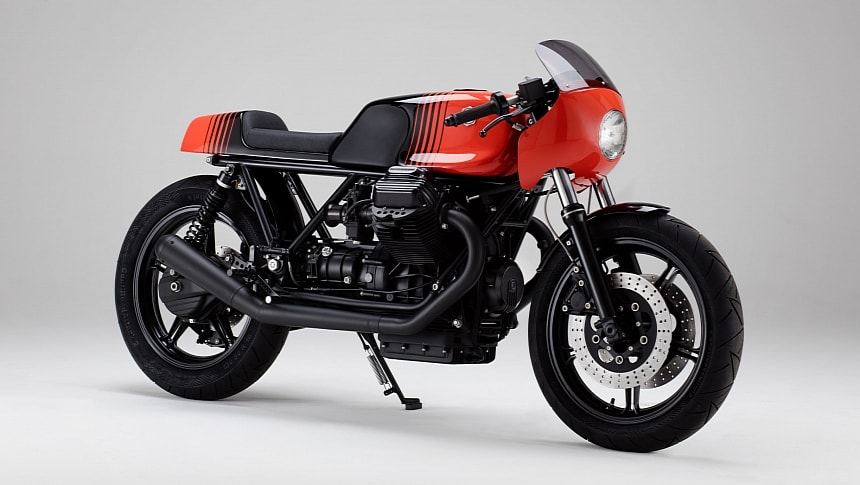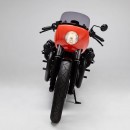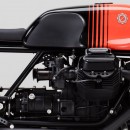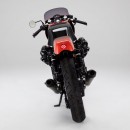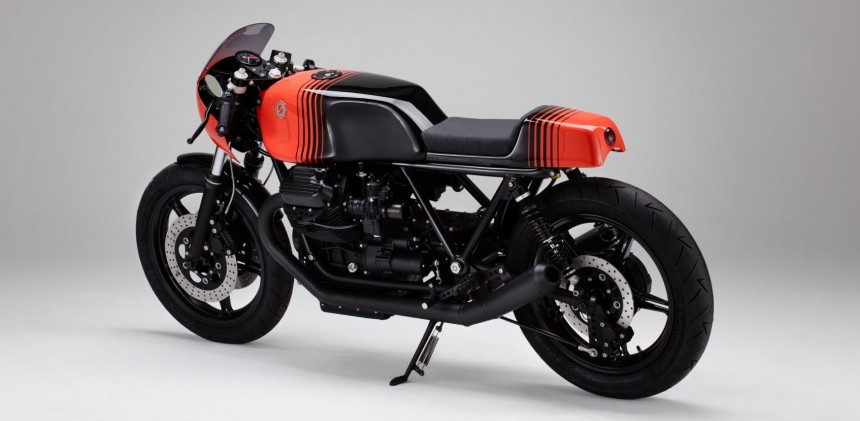In today’s custom bike world, Kaffeemaschine is synonymous with elegance and clean, OCD-soothing design. The shop is based in Hamburg, Germany and run by Axel Budde, a man who knows his way around classic Moto Guzzi models like the back of his hand. Quite frankly, we’ve been in love with Axel’s signature style from the moment we first saw it, and it's safe to assume that a lot of you feel the same.
The superb cafe racer showcased in these photos is the 22nd project he’d worked on as Kaffeemaschine, but it was a personal endeavor rather than a client commission. Although this motorcycle had been pieced together a few years ago, that certainly won’t prevent us from bringing it into the spotlight today. I mean, people still talk about Van Gogh’s famous Starry Night masterpiece from 1889, don’t they?
Axel didn’t start this build with one particular donor, instead looking to craft something along the lines of a parts bin special – or a “bitsa,” if you will. First things first, the German bike-modding guru busied himself with finding a suitable skeleton to act as the project’s basis. He ended up using the frame of a 1974 Moto Guzzi 850T but wasn’t content with leaving it unchanged.
Besides trimming its rear section for tighter proportions, Axel went so far as to integrate a crankcase breather module into the tubing at the front. This was clearly a lot easier said than done, putting all his welding and fabrication know-how to the test. Everything came together seamlessly in the end, and the V-twin powerplant housed within the framework was sourced from a Le Mans IV.
Kaffeemaschine’s mastermind had it transplanted alongside the corresponding Le Mans gearbox and shaft final drive. Of course, the engine was heavily reworked prior to installation, gaining new cylinders and pistons that raise its displacement to 1,100cc. Improved combustion is made possible by twin-spark cylinder heads, but the internal upgrades don’t end there. Fresh valves, a premium camshaft, and Carillo connecting rods also make an appearance.
Moreover, the crankshaft got rebalanced to play nice with all this juicy hardware, while the original carbs have been replaced with 40 mm (1.6-inch) Dell’Orto items. On the exhaust side of things, you’ll come across a bespoke stainless-steel arrangement wrapped in what looks like ceramic coating. The Le Mans engine is now capable of producing 97 hp at the wheel – a remarkable increase over the standard power output figures.
The structural work performed here is just as impressive. Up north, Axel used BMW triple clamps and a custom-built steering head to install the higher-spec forks of a Yamaha R6. On the other hand, rear-end suspension duties are managed by Wilbers shock absorbers with adjustable preload. There’s a lot going on in the unsprung sector, too, most notably in the form of those snazzy alloy wheels.
Originating from a Le Mans V, the hoops saw their profiles trimmed up for a skinnier appearance, and their rims were cloaked in grippy ContiRoadAttack rubber from Continental. The same Le Mans also donated its front and rear brake discs along with the wheels, and these have all been refurbished in-house. Now then, let’s talk about the specimen’s handsome cafe racer bodywork.
With carbon fiber as his material of choice, Axel fashioned a complete one-off attire from scratch to really drive the point home. The central component is a stunning fuel tank with cafe-style knee indentations, sporting an aftermarket filler cap up top and aluminum Kaffeemaschine emblems on the sides. Right behind it lies a plain handmade saddle, nicely perched atop a CFRP tail section that oozes cafe racer charm.
A circular LED taillight can be spotted out back, but the rear turn signals are discreetly attached to the subframe tubing lower down. Moving to the front end, we notice a custom fender and a stylish bikini fairing shaped like that of a Le Mans I. It encircles a retro-looking headlamp and is topped with a tinted windshield, which sits right in front of a revised Motogadget Chronoclassic dial.
In addition, the cockpit area is also home to clip-on handlebars, Kellermann bar-end blinkers, and a single rear-view mirror on the left. An array of electrical upgrades were on the menu, as well, comprising things like fresh wiring, a lithium-ion battery, and a modern electronic ignition system. Last but not least, Axel turned to Porsche’s color palette when it came to the paint job.
He picked a gorgeous Lava Orange hue normally found on the automaker’s GT3 RS models, mixing it with black by way of a very interesting transition on the tank and tail. When all was said and done, Herr Budde’s caffeinated Guzzi tipped the scales at just 181 kilograms (399 pounds) on a full stomach, thanks in no small part to its new carbon fiber overalls. Add the extra power to the equation, and you’ve got yourself one hell of a package from both a cosmetic and mechanical standpoint!
Axel didn’t start this build with one particular donor, instead looking to craft something along the lines of a parts bin special – or a “bitsa,” if you will. First things first, the German bike-modding guru busied himself with finding a suitable skeleton to act as the project’s basis. He ended up using the frame of a 1974 Moto Guzzi 850T but wasn’t content with leaving it unchanged.
Besides trimming its rear section for tighter proportions, Axel went so far as to integrate a crankcase breather module into the tubing at the front. This was clearly a lot easier said than done, putting all his welding and fabrication know-how to the test. Everything came together seamlessly in the end, and the V-twin powerplant housed within the framework was sourced from a Le Mans IV.
Kaffeemaschine’s mastermind had it transplanted alongside the corresponding Le Mans gearbox and shaft final drive. Of course, the engine was heavily reworked prior to installation, gaining new cylinders and pistons that raise its displacement to 1,100cc. Improved combustion is made possible by twin-spark cylinder heads, but the internal upgrades don’t end there. Fresh valves, a premium camshaft, and Carillo connecting rods also make an appearance.
The structural work performed here is just as impressive. Up north, Axel used BMW triple clamps and a custom-built steering head to install the higher-spec forks of a Yamaha R6. On the other hand, rear-end suspension duties are managed by Wilbers shock absorbers with adjustable preload. There’s a lot going on in the unsprung sector, too, most notably in the form of those snazzy alloy wheels.
Originating from a Le Mans V, the hoops saw their profiles trimmed up for a skinnier appearance, and their rims were cloaked in grippy ContiRoadAttack rubber from Continental. The same Le Mans also donated its front and rear brake discs along with the wheels, and these have all been refurbished in-house. Now then, let’s talk about the specimen’s handsome cafe racer bodywork.
A circular LED taillight can be spotted out back, but the rear turn signals are discreetly attached to the subframe tubing lower down. Moving to the front end, we notice a custom fender and a stylish bikini fairing shaped like that of a Le Mans I. It encircles a retro-looking headlamp and is topped with a tinted windshield, which sits right in front of a revised Motogadget Chronoclassic dial.
In addition, the cockpit area is also home to clip-on handlebars, Kellermann bar-end blinkers, and a single rear-view mirror on the left. An array of electrical upgrades were on the menu, as well, comprising things like fresh wiring, a lithium-ion battery, and a modern electronic ignition system. Last but not least, Axel turned to Porsche’s color palette when it came to the paint job.
He picked a gorgeous Lava Orange hue normally found on the automaker’s GT3 RS models, mixing it with black by way of a very interesting transition on the tank and tail. When all was said and done, Herr Budde’s caffeinated Guzzi tipped the scales at just 181 kilograms (399 pounds) on a full stomach, thanks in no small part to its new carbon fiber overalls. Add the extra power to the equation, and you’ve got yourself one hell of a package from both a cosmetic and mechanical standpoint!
